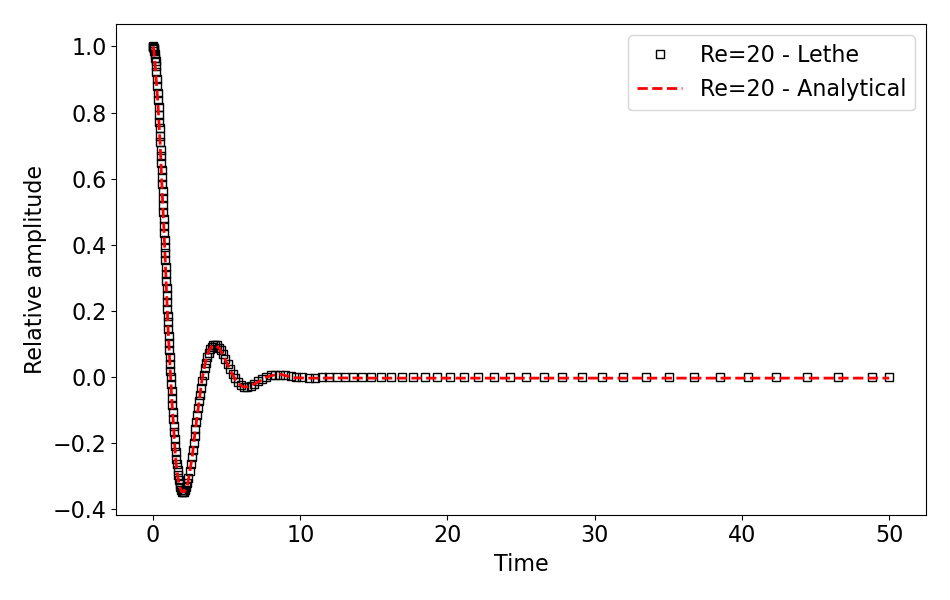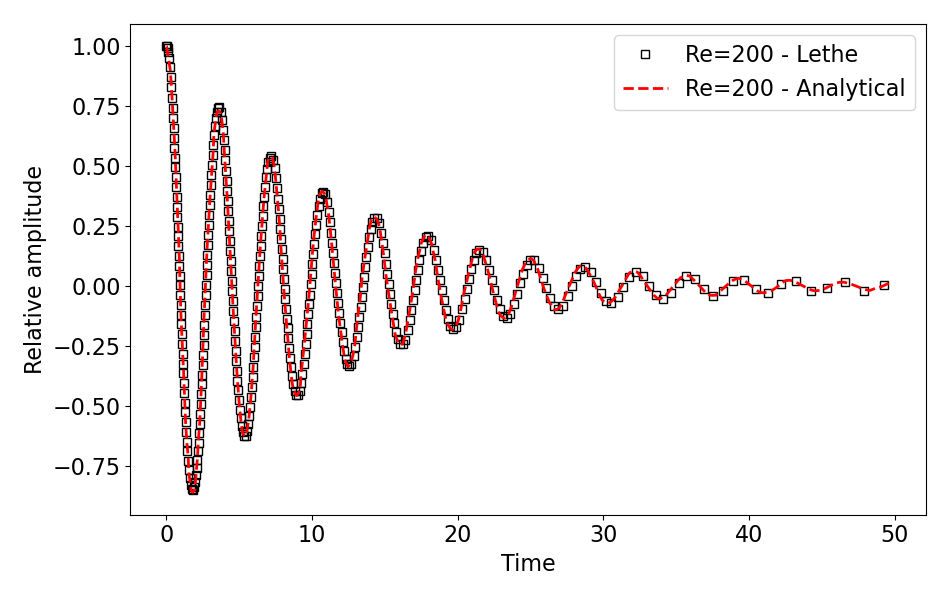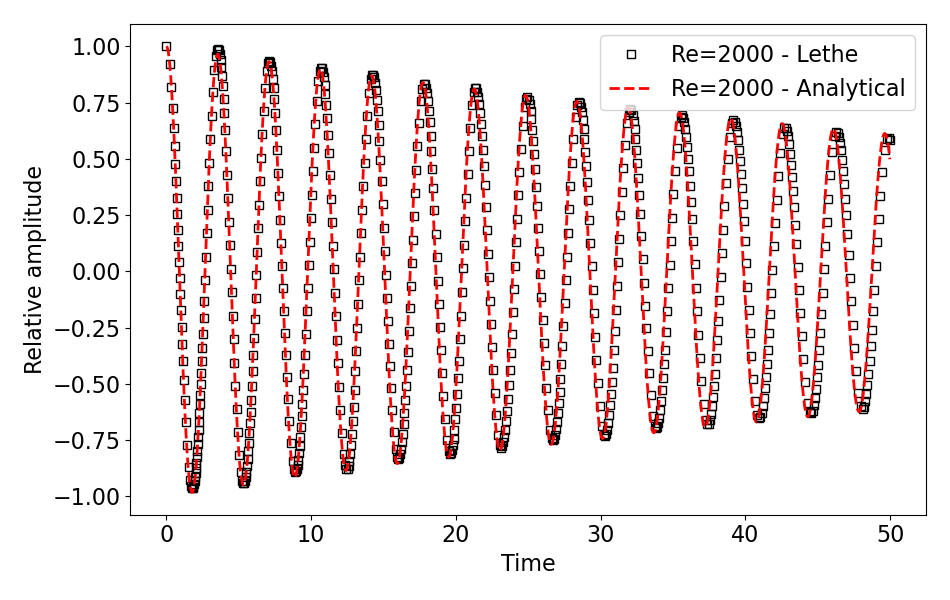Sloshing in a Rectangular Tank#
This example simulates the damping of a small amplitude wave for Reynolds number of (\(2\), \(20\), \(200\) and \(2000\)). The problem is inspired by the test case of Carrica et al. [1]
Features#
Solver:
lethe-fluidVolume of fluid (VOF)
Unsteady problem handled by an adaptive BDF2 time-stepping scheme
Usage of a python script for post-processing data
Files Used in This Example#
All files mentioned below are located in the example’s folder (examples/multiphysics/sloshing-in-rectangular-tank).
Analytical data for \(Re=2\):
sloshing_0002/analytical_solution_Re2.csvAnalytical data for \(Re=20\):
sloshing_0020/analytical_solution_Re20.csvAnalytical data for \(Re=200\):
sloshing_0200/analytical_solution_Re200.csvParameter file for \(Re=2\):
sloshing_0002/sloshing-in-rectangular-tank_Re0002.prmParameter file for \(Re=20\):
sloshing_0020/sloshing-in-rectangular-tank_Re0020.prmParameter file for \(Re=200\):
sloshing_0200/sloshing-in-rectangular-tank_Re0200.prmParameter file for \(Re=2000\):
sloshing_2000/sloshing-in-rectangular-tank_Re2000.prmPostprocessing Python script:
sloshing_postprocessing.py
Description of the Case#
Predicting the dynamics of free surface waves is essential for many industrial applications (e.g. transport of liquefied natural gas). Yet, simulating their dynamics is difficult, especially for high Reynolds number values. Indeed, in this case, the amplitude of the waves dampen very slowly. This leads to an oscillatory wave problem which is highly sensitive to the time integration scheme and the coupling between the VOF solver and the Navier-Stokes solver.
In this problem, we simulate the damping of a small amplitude wave in a rectangular cavity defined from \((-1,-1)\) to \((1,0.1)\). The initial height of the wave \(\xi (x)\) is given by:
Initial height of the wave# |
Four values of the Reynolds number are investigated: \(2\), \(20\), \(200\) and \(2000\).
Parameter File#
Simulation Control#
The results for this problem are highly sensitive to the accuracy of the time-stepping scheme. For this reason, we use a 2nd order backward differentiation scheme (bdf2) with a variable time-step. The adaptive time step scaling is set to \(1.025\) to ensure that the time-step does not rise too quickly during wave oscillations.
subsection simulation control
set method = bdf2
set time end = 50
set time step = 0.01
set adapt = true
set max cfl = 0.25
set output name = sloshing-in-rectangular-tank_Re20
set output path = ./output_Re20/
set output frequency = 1
set adaptative time step scaling = 1.025
end
Multiphysics#
The multiphysics subsection is used to enable the VOF solver.
subsection multiphysics
set VOF = true
end
Initial Conditions#
In the initial conditions, we define the initial height of the wave, such that the interface (\(\phi = 0.5\) isocurve) lies at the right height.
subsection initial conditions
set type = nodal
subsection uvwp
set Function expression = 0; 0; 0
end
subsection VOF
set Function expression = if (y<=(0.01*sin(3.1416*(x+0.5))), min(0.5-(y-0.01*sin(3.1416*(x+0.5)))/0.0025,1), max(0.5-(y-0.01*sin(3.1416*(x+0.5)))/0.0025,0))
end
end
Mesh#
In the mesh subsection, we define a hyper rectangle with appropriate dimensions. The mesh is initially refined 6 times to ensure adequate definition of the interface.
subsection mesh
set type = dealii
set grid type = subdivided_hyper_rectangle
set grid arguments = 5, 2 : -1, -1 : 1, 0.1 : true
set initial refinement = 6
end
Physical Properties#
The physical properties are mainly used to establish the Reynolds number of the sloshing liquid. For the air, however, the work of Carrica et al. [1] does not give any physical properties. We thus fix the air to be significantly less dense than the liquid, but we keep its viscosity at a certain reasonable viscosity to ensure numerical stability.
subsection physical properties
set number of fluids = 2
subsection fluid 0
set density = 0.001
set kinematic viscosity = 0.001
end
subsection fluid 1
set density = 1
set kinematic viscosity = 0.5
end
end
Source Term#
The source term subsection is used to enable the gravitational acceleration along the \(y\) direction.
subsection source term
subsection fluid dynamics
set Function expression = 0 ; -1 ; 0
end
end
Running the Simulation#
We can call lethe-fluid for each Reynolds number. For \(Re=20\), this can be done by invoking the following command:
to run the simulation using eight CPU cores. Feel free to use more.
Warning
Make sure to compile Lethe in Release mode and run in parallel using mpirun. This simulation takes \(\sim \, 8\) minutes (\(Re=2\)) to \(6\) hours (\(Re=2000\)) on \(8\) processes.
Results#
We compare the relative height of the free surface at \(x=0\) with an analytical solution proposed by Wu et al. [2] For the Reynolds number of \(2\), \(20\) and \(200\), data were directly extracted from Carrica et al. [1], whereas for the Reynolds of \(2000\), the simplified analytical expression of Wu et al. [2] is used. The results for Reynolds number of \(2\), \(20\), \(200\) and \(2000\) can be postprocessed by invoking the following command from the folder of the Reynolds number of interest (\(Re=20\) in the example below):
Important
You need to ensure that the lethe_pyvista_tools is working on your machine. Click here for details.
The following table presents a comparison between the analytical results and the simulation results for all Reynolds numbers mentioned above. A very good agreement is obtained for each of them, demonstrating the accuracy of the VOF solver.
Re |
Results |
|---|---|
\(2\) |

|
\(20\) |

|
\(200\) |

|
\(2000\) |

|